

![]()
 Looking down at the 1977 "L" accident from the downtown offices of the Central Electric Railfans' Association. (Photo by M. Charnota) |
On this particular day, switching problems had caused Evanston Express trains to operate counterclockwise around the outer loop track instead of clockwise on the inner, as normal. The problem was corrected at approximately 5:10pm, but a few Evanston trains that had already begun their trip around the Loop were continuing to operate on the outer track. As can be imagined, the extra trains on the outer track caused some minor delays.
At approximately 5:25pm, one such Evanston Express was loading and unloading passengers at the State/Lake station. A Ravenswood train was following and had stopped on the track behind the Evanston Express, waiting for the Evanston to clear the station so that it could pull in. At the same time, an Oak Park-bound Lake-Dan Ryan train was boarding and alighting riders at the Randolph/Wabash station, two blocks away and around the bend from State/Lake.
The motorman of the Lake-Dan Ryan - one Stephan A. Martin, age 34, a motorman since 1969 - completed his station duties and pulled his train out of Randolph/Wabash. Somehow, it escaped his attention that there was a train stopped on the tracks ahead, although this information was being relayed to him both visually and audibly by the new automatic cab signaling system installed in his motor cab. He proceeded against the restrictive signal at a speed of less than 15mph (thus staying under signal control), around the Lake & Wabash curve, into collision with the stopped Ravenswood train at 5:27pm.
Making matters worse, Martin continued to apply motor power, even after the collision! The 8-car Lake-Dan Ryan, with 2,500 kw of power behind it, pushed against the immovable Ravenswood train. This application of power, coupled with the fact that the train was on a 100 ft. radius elevated curve, caused the tubular coupling bar between the first and second cars to buckle, pushing the rear of the first car and the front of the second into the air. The first three cars were lifted sufficiently upwards and outwards that they jackknifed and crashed to the street below, the fourth car (still coupled to the rest of the train) hanging precariously between the elevated structure and the street below. The last four cars stayed on the tracks, still berthed at the Randolph/Wabash station platform.
Barbara Coats, 35, a passenger in the first car of the Lake-Dan Ryan train, said after the accident, "It wasn't a big impact, but it was like we hit something and couldn't go any farther. After the front wheel went off, I was just praying we couldn't fall off - but we did."
Ambulances and police rushed to the scene in minutes, the ambulances lining up on Lake Street waiting to move the dead and injured. Fire Commissioner Robert Quinn called an immediate extra alarm to hurry needed man power to the intersection, which was blocked by the wreckage. Police and firemen worked for two hours to free persons trapped in the wreckage, chopping holes in the tops of the elevated cars to extricate victims.
Some people were treated on the street before being loaded into ambulances. Other were taken into nearby stores and restaurants, which were turned into makeshift infirmaries. Joining the city departments already at the scene were Mayor Michael Bilandic and Cardinal Cody, who, along with other priests, administered last rites to some of the victims.
In all, eleven persons were killed (though the newspapers mistakenly reported twelve, initially) and 180 were injured in what has been the worst "L" accident to date.
Through the cooperation of several agencies, the site was completely cleared of all wreckage and debris in about twelve hours and normal operations were restored by 6:30am the next morning.
The cars involved in the accident were impounded at the Skokie Shops yard, pending investigation of the crash. The first four cars, 2000-series unit 2043-2044 and 2200-series unit 2289-2290, were so badly damaged that they were removed from service and eventually scrapped. The rest of the cars were repairable and were eventually returned to service.
Stephan Martin, the Lake-Dan Ryan motorman, had a poor safety record including such things as a prior derailment and several violations for reading while in motion. He had four marijuana cigarettes in his shoulder bag, and drug tests showed he had used marijuana, but not other drugs or alcohol. His conductor, who had eaten lunch with him, testified they had not smoked marijuana during lunch.
Martin was ultimately held responsible, though the report from the National Transportation Safety Board did not address the issue of how the accident could have occurred if the cab signal was giving a restrictive indication. Some CTA officials felt the accident could have occurred if Martin had remained at a slow enough speed to override the automatic signal, then quickly applied power when pushing against the immovable Ravenswood train. (The way the cab signals originally worked, a motorman had a couple seconds to slow down or stop -- depending on the situation -- when he received a restrictive signal or the train's breaks would automatically engage. But, on occasion, the cab signal system would receive "ghost signals," an indication that there was a train ahead when there really wasn't. So, if this was the case, a motorman could proceed "on-sight" at under 15 mph against a restrictive signal as long as he makes a full stop first.)
The popular theory of what happened goes like so: the motorman, while approaching the Randolph/Wabash station, got a restrictive signal indication and the alarm in his cab went off. But, making the normal station stop, he inadvertently overrode the signal, which allowed him to proceed. He left the station and proceeded under 15 mph, which prevented the automatic braking from engaging. What happened next is open to speculation. Some say that Martin, who was known to talk to passengers (especially female ones) while motoring, was doing just that while approaching the Ravenswood train ahead and didn't see the impending collision. When his train struck the stopped Ravenswood, it is believed that he either panicked and accidentally applied more power instead of braking or that the sheer force of the impact threw him forward and, as a result of his hand being on the Cineston controller, threw the control forward as well.
These exact details cannot and perhaps will never be 100% confirmed. But, as a result of this accident, motorman can no longer proceed on their own "on-sight" against a red signal. A new rule, Rule 6.4, was put in the CTA rule book. This regulation says that when a motorman receives a false red signal, he must call the Control Center to get permission to proceed. A light in the cab labeled "R6.4" lights up and only on permission from control can he proceed at under 15 mph against the signal. This situation is often referred to as "getting an 'R6.4'."
Such an accident is unusual for a number of reasons, but especially for how such a complicated automatic signal system was unable to prevent the occurrence. It also stressed that any signal system, no matter how complex, can not prevent every circumstance and reasserted the importance of proper and thorough training. Thus, this type of incident is unlikely to be repeated any time in the future...
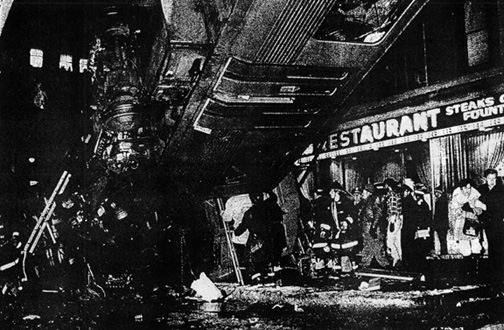 Its undercarriage twisted by the impact, the Lake-Dan Ryan car is upended above Wabash Avenue. Two firemen assist a passenger from one of the exit doors. Impact startled patrons at adjacent restaurants at height of rush hour. (Photo from the Chicago Tribune) |
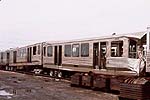 |
2200-series unit 2289-2290 sits in the Skokie Shops yard in June 1977, awaiting to be scrapped after the infamous crash that February at the Wabash/Lake curve in the Loop. (Photo by Peter Vesic) |
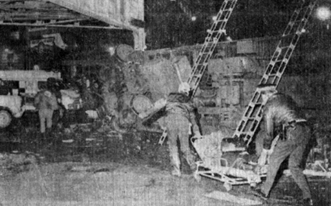 |
Rescue and emergency workers remove injured passengers from the fallen Lake-Dan Ryan cars and tend to them. (AP photo, contributed by Michael Roegner) |
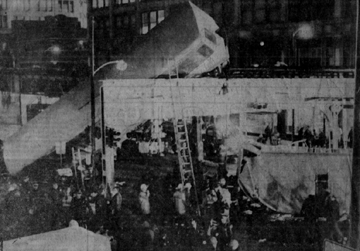 |
A 2000-series car from the Lake-Dan Ryan train rest precariously against the "L" structure after falling from the tracks. (AP photo, contributed by Michael Roegner) |
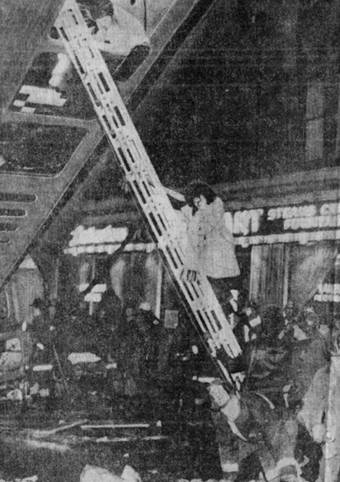 |
Rescue workers assist a woman out of a fallen car on Wabash Avenue. (UPI photo, contributed by Michael Roegner) |
![]()
Sources:
Cudahy, Brian J. , Destination Loop, Brattleboro, VR: The Stephan Greene Press, 1982.
Krambles, George and Arthur Peterson, CTA at 45, Oak Park, IL: George Krambles Scholarship Fund, 1993.
Newspaper articles:
Young, David M. Chicago Transit: An Illustrated History, DeKalb, IL: Northern Illinois University Press, 1998.